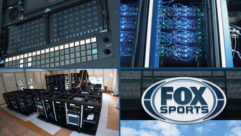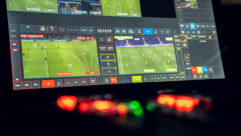Breaking Into The Sports AV Business
It’s the contract of your dreams. Your NCAA Division I alma mater is planning a multi-million dollar renovation to its football stadium that includes a new PA system, a fiber optic cabling upgrade, scoreboard video, and AV toy-laden skyboxes.
It’s the contract of your dreams. Your NCAA Division I alma mater is planning a multi-million dollar renovation to its football stadium that includes a new PA system, a fiber optic cabling upgrade, scoreboard video, and AV toy-laden skyboxes. You’ve done scores of installs with similar technical characteristics. Because scale appears to be the only real difference between them and this opportunity, you figure it’s a job you can tackle.
MINOR LEAGUE AND COLLEGE OPPORTUNITIES
In sports-crazy America, there’s seemingly no end in sight to building and upgrading stadiums and arenas. That’s good news for AV systems integrators.
While the building cycle for Major League venues has generally been turning down, minor leagues and colleges are stepping in to fill the gap. Mimicking the pros, they want the best AV systems money can buy.
“We’re seeing more opportunities in minor leagues and colleges, where speaker system renovations and adding video capabilities to static scoreboards are common projects,” says Stuart Reynolds, senior consultant with Acoustic Dimensions, a Dallas-based AV systems consulting and design firm.
Confirming that college athletics is, in fact, big business, colleges are throwing a lot of money at AV. Jeff Volk, who heads the sports entertainment group at Alpha Video in Edina, MN, says NCAA Division I schools are regularly shelling out a half million dollars for systems. On the pro side, the range is $1.5 to $3 million, with many spending more than $1 million on their large LED displays alone.
Minor leagues, most notably baseball, are building more stadiums, as well. According to a recent article in Amusement Business magazine, 102 new stadiums have been built in the United States and Canada since 1990. Setting new attendance records, the leagues are flush with cash to spend on new stadiums and existing stadium renovations.
But don’t count the pros out as a future market. While many cities are sitting on new stadiums that likely won’t be replaced or upgraded for years, the cycle hasn’t bottomed yet. In New York City, for example, every major franchise that calls the metro area home is angling for a new home.
“That’s a real hotbed of activity now,” says George Douglas, senior vice president with SPL Integrated Solutions, a Columbia, MD-based systems integrator. “While the pro market has slowed down, it seems like one pro job a year still comes our way. But both the minor leagues and colleges have been the strongest.”
However, the odds that a typical AV systems integrator can get a foot in the door to even bid on designing or installing a job of this magnitude are not completely in your favor. Simply put, your technical skills and even your way with people probably won’t be enough to override your lack of a track record in the sports venue market. “Getting big sports venue jobs boils down more to a matter of getting to know the right people than learning the technology,” says Jeff Volk, head of the sports and entertainment group at Alpha Video, an Edina, MN-based integrator that managed to crack the market two years ago, but not before pumping a lot of arms and paying a lot of dues. “Plus, it takes a company of a certain size and financial strength because of issues like insurance and bonding.”
Bonding requirements can be particularly onerous. “It can range from 1.5 to 4 or 5 percent of the job,” Volk says. “The amount depends on things like your financial strength and your performance on past projects. But if you’re an integrator that has multiple jobs going on at any one time, you’re probably going to need a $2 to $3 million bonding capacity.”
Secondly, even if you were to win the job with a convincing show of competency – not to mention a low bid that might make you sweat – the chances of your high-profile dream job descending into a nightmare are high. Tight deadlines tied to opening dates carved in stone, project management, demanding clients, contracts that harshly penalize, and coordinating with other contractors — all that and more might make you cry “do-over.”
For another picture of the market, though, consider the observations of Bobby Taylor, a director with All Pro Sound, a Pensacola, FL-based integrator. His 25-year-old company has been installing systems in college stadiums and arenas for about eight years. Though the task of landing a sports job can be tedious, Taylor says it’s not an impossible market to crack.
“Talent, resources, and knowledgeable techs are essential to being able to support a job for a major venue,” he says. “Before we got into the market, we had done well in other markets with large venues consistent with stadiums and arenas, such as churches. The same basic equipment is used; it’s just that the scale is different.”
Bright spot or blind spot?
Who to believe? Ultimately, it may not matter. The fact is, the broad sports venue market, which also includes the equally dynamic, but significantly more accessible Minor League, small college, and high school markets, is one of the real bright spots on the AV systems integration business horizon. (See sidebar). Someone’s going to get that business. Finding it, though, and then getting comfortable with how business is done in the market can be challenging.
SPORTS AV RESOURCES
Associations:
- National Associations of Sports Commissions (NASC) is the primary network for communication and information sharing on topics relating to the sports event industry (www.sportscommissions.org).
- Information Display and Entertainment Association (IDEA) is an international association of electronic display system and scoreboard operators (www.ideaontheweb.org).
- Association of Luxury Suite Directors (ALSD) is a member association for the premium seating marketplace (www.alsd.com).
- The International Association of Assembly Managers (IAAM) comprises leaders in entertainment, sports, conventions, trade, hospitality, and tourism (www.iaam.org).
- The World Council for Venue Management (WCVM) unites major associations representing public assembly venue industry professionals and facilities, including 1,200 of the world’s stadia, arenas, and coliseums (www.venue.org).
Conferences:
- National Association of Sports Commissions’ Sports Event Symposium (www.sportscommissions.org) April 18-21, 2006, Lexington, KY
- Information Display and Entertainment Association’s 24th Annual Conference (www.ideaontheweb.org) February 2006, Southern California
- Association of Luxury Suite Directors’ 2005 Conference and Trade Show (www.alsd.com) June 27-30, 2005, Atlanta
- Stadia & Arena Exhibition and Conference (www.sam.uk.com) Dates TBD.
- The International Sports Summit (www.sportsummit.com) Dates TBD.
Publications:
- Big Screen magazine (from IDEA) follows IDEA’s mission of providing a forum for its members to learn, exchange, and discuss electronic display industry information.
- SEAT magazine (from ALSD) provides information about the trends and changes in the premium seating industry.
- Stadium & Arena Management magazine targets professionals that develop, design, construct, and manage large sports facilities (www.sam.uk.com).
- Facility Manager magazine(from IAAM) provides information about public assembly facilities management.
A good place to begin looking for possible buyers is within groups that represent their interests (see sidebar at bottom of opposite page.) Getting to know buyers in the trade organizations is essential for would-be suppliers. “From the end-user side, this can be a very tight-knit and even closed community,” Volk says. “The first 18 months of our foray into the market netted us no business but allowed us to go to trade shows and get our face out in the marketplace and then to bid.”
Steve Durr of Durrell Sports, an audio system design, production, and service company in Nashville, TN, has hooked up with numerous sports venue buyers by just keeping his ear to the wind. “Most of our business has come from client referrals, but we’re also on the lookout for venues where the sound isn’t good,” he says.
Motor speedways is one such market Durrell has uncovered. “Eighty percent sound bad,” he says. “But the typical buyer in that market isn’t all that tech savvy, and they don’t care as long as no one is complaining. So you need to find situations where complaints about sound may be growing.”
Even then, Durrell says, the challenge is just beginning. Often getting the go-ahead to proceed with a system upgrade can be a drawn-out experience. “Getting things approved and having to deal with a lot of people on different boards can sometimes be more difficult than the technical aspects,” he says.
Volk, too, says navigating the multiple layers of decision-makers in the market can pose a major challenge. Moreover, each project is unique in terms of who’s involved, the extent to which they are comfortable with technology, and their understanding of what needs to or can be done. “You could line up 10 different organizations and each would be different in how the decision-making is structured,” he says. “In the college market, for instance, the decision-maker may be in the athletic department’s marketing area or the communications department or maybe even the journalism school where they’re using the project as a teaching vehicle. On pro jobs, you have to deal with team officials as well as city/state/county people.”
Volk adds that the level of technical knowledge for the typical buyer is highly variable. Most, though, have a good basic grasp of the technology and are able to communicate what they want. “In most cases on the pro side people from the team have a hand in designing the system, and they know what they want from a creative standpoint,” he says. “Then it’s our role to find the equipment that will provide the solution.”
A defining characteristic of the sports AV market is the sheer size and scope of most projects. From a design perspective, they demand a high comfort level with developing sound and video solutions on a scale many companies can’t fully comprehend. “They’re different in the engineering aspect because you’re often dealing with very large coverage areas and sometimes much higher sound pressure level requirements,” Taylor says.
George Douglas, senior vice president of SPL Integrated Solutions, a Columbia, MD integrator, says stadium and arena projects demand ever-more elaborate design and installation solutions. “They’re full production facilities now – more sophisticated, computerized, and networked. You have local networks, in-house networks, and on-air networks involved that require a very complex infrastructure.”
An overwhelming environment
While essential, technical skills alone won’t ensure success in the sports market. “Systems contractors that do well on these projects are those that are savvy in construction independent of their AV technical skills,” says Jack Wrightson, a principal with WJHW, a Dallas-based AV systems design firm that specializes in the sports market. “Over the years we’ve seen smaller contractors perfectly capable from a technology standpoint get in trouble because they didn’t understand what’s involved in multi-million dollar construction projects.”
Rick Walter, vice president of sales of Diversified Systems, a leading sports venue systems integrator in Kenilworth, NJ, says Diversified has grown comfortable working in a market where unpredictability can be especially hard on inexperienced systems integrators. “To successfully implement these projects, you have to consider that you’re at the end of the food chain, and if other contractors slip in schedule you must be able to pick up the slack,” he says. “Primarily, it takes very strong project management skills to manage things like scheduling and cash flow.”
While systems integrators routinely subcontract for general contractors or electricians, the route to many of the bigger jobs typically goes first through experienced consultants and designers like WJHW and Dallas-based Pelton Marsh Kinsella (PMK). However, design-build opportunities exist for capable integrators.
However the work is structured, SPL Integrated Solutions’ Douglas says integrators have to pay close attention to the bid preparation process. Contractors under the gun to finish projects on time and on budget show little mercy. “A lot of people don’t bid these sports jobs correctly,” he says.
Jobs in the sports market will also give you a new appreciation for the meaning of a completion deadline. While most projects are performed in the off-season, opening day is non-negotiable. As in other markets, AV work is typically done at the tail end.
James Bush, production manager for United Spirit Arena, the Lubbock, TX, home of the Texas Tech University basketball team that recently got a major AV facelift, says arena managers have little patience for foot dragging. Integrators were subject to penalties of up to $500 a day if they missed deadlines. “They’re expected to meet real dates,” he says.
A long, involved process
Final system commissioning can be the culmination of months of tedious work. Bid preparation; routine client and contractor meetings; work that often involves building and wiring massive systems off-site, followed by tear-down, transport to the site and re-assembly; constant monitoring of other contractors’ work progress – all contribute to making the completion of projects a challenge. Those familiar with the market say a year can pass from the time pre-bid conferences open until a project is finally complete.
As vital as AV systems are becoming in terms of improving the game-day experience for fans and delivering the sophisticated media capabilities that venue advertising sponsors demand, many clients are taking a more hands-on approach to AV installations. “We insisted on a pre-bid conference that involved potential integrators because we wanted everyone to see what we were trying to do firsthand,” Bush says. “It’s one thing to tell people we wanted to put a line array system in; it’s another to be able to see and hear why it was needed. We used the meeting to explain what we wanted to do and also to hear integrators suggest possible alternate solutions.”
Bush’s tactics, which also included vetting consultants and integrators to find those who “have a depth of knowledge and really know the technology” is evidence that AV is no longer an afterthought in sporting venues.
“Many of these projects are sexy,” Volk concedes. “You think about the big money and the coolness of being involved with a sports team project. But the fact is there are a lot who come and go in this market. To be successful, it can take a lot of lead time to develop an identity and then when you get in, the margins aren’t tremendous. Serving the market requires a lot of dedication.”
Tom Zind is a freelance writer and researcher based in Prairie Village, KS. He has written for a variety of business-to-business publications and can be reached at [email protected].










